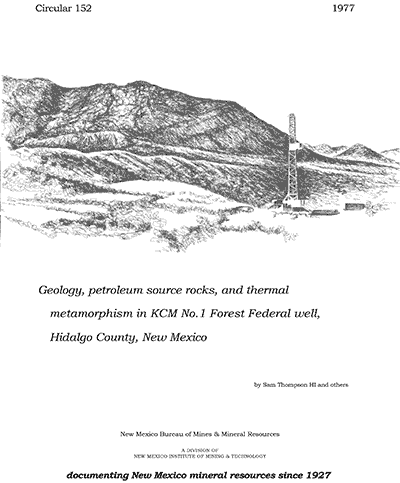
Circular 152—Geology, petroleum source rocks, and thermal metamorphism in KCM no.1 forest federal well, Hidalgo County, New Mexico
By S. Thompson III and others, 1977, 62 pp., 13 tables, 19 figs.

Six separate papers that cover several geologic aspects of the KCM No. 1 Forest Federal well. In southwestern New Mexico and adjoining areas, the Paleozoic and Mesozoic sedimentary section contains several petroleum source and reservoir units; however, metamorphism by Tertiary plutons has deterred exploration. Preliminary investigations indicate that the most severe effects of thermal metamorphism are limited vertically and laterally to relatively short distances around the plutons.
In this circular, we show that the KCM No. 1 Forest Federal well encountered fair to possible good source of petroleum in the deep-marine mudstones and limestones of the Permian-Pennsylvanian section. We also show that the lower part of the section was metamorphosed by Tertiary intrusives and that the thermal effects decrease in the upper part. This KCM well provides an unusual opportunity to observe such thermal effects in a vertical sequence containing petroleum source units. The KCM company generously released the samples, logs, and other essential well data for these studies. Several specialists were invited to contribute the needed research from their respective fields. The results of this research are compiled as a collection of individual papers. Some repetition of main points is necessary for each paper to be complete.
The introduction of the first paper presents the regional geologic setting and the surface location of the well on the Inkler anticline. The main part of the paper presents the general results of the subsurface geology followed by documentation with specific results of stratigraphic and other analyses. The summary emphasizes the significance of these results in the exploration for petroleum. The second and third papers treat special aspects of the basic geology. Behnken presents the paleontological evidence based on conodonts used in dating the stratigraphic section; he also discusses the conodont alteration index of Epstein and others. Budding and Broadhead identify the igneous and metamorphic rocks in the well and document the intensity of contact metamorphism.
Cernock Bayliss in the fourth paper determine organic geochemical zones, discuss the thermal maturity based mainly on kerogen analysis, and evaluate the hydrocarbon source potential. Ewing and Thompson in the fifth paper review concepts dealing with organic metamorphic facies and estimate the level of organic metamorphism in the well. Elston and Erb in the last paper present field evidence that the Tertiary volcanic cauldrons around the well are surface expressions of the plutonic complex below. The limits of the cauldrons aid in projecting the lateral extent of thermal alteration.
The results given in this publication are sufficient for a basic interpretation
of the geology and an evaluation of the source units of petroleum in this
KCM well. However, most of these authors are continuing their research on
this well; other specialists are adding knowledge from different fields.
Other wells and surface exposures are being studied to increase our knowledge
of the geologic framework, determine the position of petroleum source and
reservoir units within the framework, and delineate the limits of thermal
alteration that may have affected the accumulations of oil and gas in the
southwestern New Mexico.
$7.25
Buy
Now
Also available as a free download.
Download
| File Name | Size | Last Modified |
|---|---|---|
| Circular-152.pdf | 2.92 MB | 01/11/2021 03:00:57 PM |



